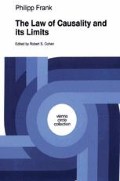Abstract
Whereas we have spoken so far (especially in chapter I) quite plainly of the world of our experiences as of the ‘real’ world, we must now say something about a manner of speaking that uses ‘real’ and ‘experience’ as designating a pair of opposites. The difference between the terms ‘real’ and ‘apparent’ plays a great role in ordinary life as well as in natural science. For example we say: ‘apparently’ the detective took a quiet walk, but ‘really’ he carefully watched the entrance to a jeweller’s shop. Or: The stone on which I stepped was ‘apparently’ quite fast, but it was ‘really’ so loose that it broke off.
Access this chapter
Tax calculation will be finalised at checkout
Purchases are for personal use only
Preview
Unable to display preview. Download preview PDF.
References
Russell, Bertrand, Unser Wissen von der Aussenwelt (1914). German translation by W. Rothstock, Leipzig 1926 [Our Knowledge of the External World (1914)]. Carnap, R. Der logische Aufbau der Welt, Berlin (1928) [The Logical Structure of the World (1967)].
Frank, Ph., Was bedeuten die gegenwattigen physikalischen Theorien fur die allgemeine Erkenntnislehre?’, Naturwiss. (1929) and Erkenntnis I, 126ff (1930) [Translated as ‘Physical Theories of the 20th Century and School Philosophy’, Modern Science and Its Philosophy, ch.4, pp. 90–121 (1949); earlier in Between Physics and Philosophy (1941)]. Bavink, B., Ergebnisse und Probleme der Naturwissenschaften. Eine Einführung in die heutige Natur-philosolphie, 4th edition, pp.217ff, Leipzig (1930). Planck, M., Positivismus und reale Aussenwelt, Leipzig (1931).
Schrödinger, E., Veber die Kräftefreie Bewegung in der relativistischen Quantenmechanik’, Sitzgsber. preuss. Akad. Wiss. Physik.-math.K1. (1930), 418ff.
Planck, M., ‘Das weltbild der neuen Physik’, Mh. Mathematik and Physik 36, 387ff (1929). Heisenberg, W., Die physikalischen Prinzipien der Quantentheorie, p. 11, Leipzig (1930). Dirac, P.A.M., Die Prinzipien der Quantenmechanik, German translation by W. Bloch, pp.7ff, Leipzig (1930) [The Principles of Quantum Mechanics, first ed. (1928)]. Schrödinger, E., address at inauguration as member of the Prussian Academy, Sitzgsber. preuss. Akad. Wiss, Physik-math. KI (1929). P. Langevin turns against the misuse of quantum theory in favour of a metaphysically tinted indeterminism, in his publication La science et le déterminisme, Paris (1930).
Carnap, R., Scheinprobleme in der Philosophie, Berlin (1928) [See note to chapter I, section 4].
Frank, Ph., ‘Die Bedeutung der physikalischen Erkenntnistheorie Machs fur das Geistesleben der Gegenwart’, Naturwiss. 5 (1917) [The Importance of Ernst Mach’s Philosophy of Science for our Times’, in Frank, Modern Science and its Philosophy, chapter II, pp.61–78 (1949); and in Ernst Mach Physicist and Philosopher, Appendix A, pp. 219–234 (Boston Studies in the Philosophy of Science, vol. 6, 1970)]. The “great work of enlightenment done by the physicist and philosopher Ernst Mach which - after a short time of misunderstanding - now begins to have a far-reaching effect”, is pointed out by R.v. Mises in his address Veber das naturwissenschaftliche Weltbild der Gegenwart’, Naturwiss 19 (1931). We also already understand today what is correct in the view advocated by Mach, that physics has not to investigate the atoms but the observations, a view that for a long time was thought to be especially shocking, and as retarding ‘creative activity’. For Heisenberg, one of the main creators of today’s quantum mechanics, said at the meeting in Königsberg: “Modern atomic physics does not deal with the character and structure of atoms, but with the events that we perceive when we observe atoms” (Erkenntnis II).
The meaninglessness of ‘ignorabimus’ from the standpoint of a purely scientific world conception is decisively advocated by R.v. Mises in his address quoted in the notes to section 13, as well as in my own Prague lecture, Naturwiss. 17 (1929). From the logical construction of all statements about the real world which Ludwig Wittgenstein and Rudolf Carnap tried to carry out, it follows expressly that no meaningfully put scientific question can be unsolvable in principle. Wittgenstein, in his Logisch philosophische Abhandlung, Ann. d Nat. u. K Phil. XIV (1921), says for example: “If an answer cannot be expressed, the question cannot be expressed either” (or: “To an answer that cannot be worded the question cannot be worded either” [Wittgenstein, Tractatus]). R.Carnap (Der Logische Aufbau der Welt, p.183) says: “The proud thesis that no question is in principle unsolvable for science agrees very well with the humble insight that, even after all questions have been answered, the problem which life poses for us has not yet been solved” [The Logical Structure of the World p.297]. Otto Neurath attempts, in his essay ‘Sociology in physicalism’ (Erkenntnis II), to exclude each comparison of statement and experience as a criterion of the truth of a theory and to retain only the comparison of statements with statements [’Sociology in the Framework of Physicalism’, Otto Neurath, Philosophical Papers 1913–1946, ch.6, pp. 58–90 (Vienna Circle Collection, vol.16, 1983)].
Brunswik, A., 1.c., pp.30ff.
Boutroux, E., Science et religion, pp.251ff, Paris (1925).
Petzold, J., Das Weltproblem vom Standpunkt des relativistischen Positivismus aus, 2nd ed., Leipzig & Berlin (1912).
Nietzsche, Fr., Fröhliche Wissenschaft, Nr.193 [The Gay Science, Lc].
Nietzsche, Fr., Works left behind, Der Wille zur Macht, in Nietzsches Werke, vol.15, Leipzig (1901) [Will to Power (1967)], Nr.287, 289, 245, 248. Heidegger, Martin, Was ist Metaphysik?, p.27, Bonn (1930) [What is Metaphysics? in Basic Writings (1977)].
Bergmann, H., l.c., pp4ff.
Author information
Authors and Affiliations
Editor information
Editors and Affiliations
Rights and permissions
Copyright information
© 1998 Springer Science+Business Media Dordrecht
About this chapter
Cite this chapter
Frank, P., Cohen, R.S. (1998). On the So-Called ‘True’ World. In: Cohen, R.S. (eds) The Law of Causality and Its Limits. Vienna Circle Collection, vol 22. Springer, Dordrecht. https://doi.org/10.1007/978-94-011-5516-8_10
Download citation
DOI: https://doi.org/10.1007/978-94-011-5516-8_10
Publisher Name: Springer, Dordrecht
Print ISBN: 978-94-010-6323-4
Online ISBN: 978-94-011-5516-8
eBook Packages: Springer Book Archive

